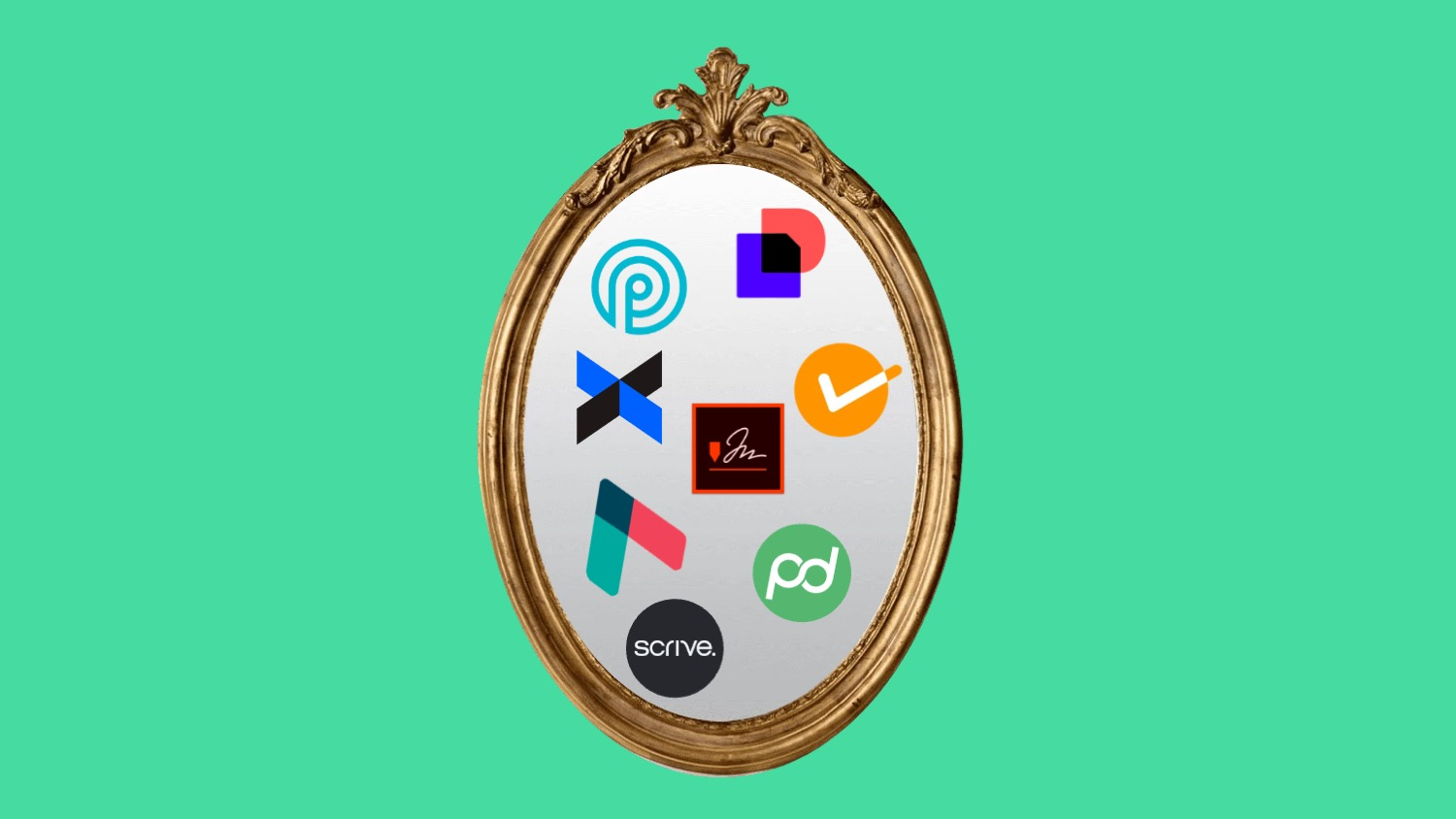E-signing solutions have been around for a while now. And the adoption of the technology has drastically increased over the past year as the global workforce has gone remote, with access to printers, scanners, or fax machines becoming limited.
If you still haven’t gone down the e-signing route but have been tasked within your company to explore the different options, then you’ve come to the right place. We put together a Request for Proposal (RFP) template of things to consider when going shopping for an e-signing solution. Below, we break down each area in more detail.
Company Information
The first part is about your organization: company name, the year it was founded, etc… It is mostly generic information that won’t impact the rest of the template, but there are two important questions to keep in mind throughout your purchasing process:
- Vision & Mission - What does your company stand for? It is good to write down what your company goals and values are and make sure you align yours with those of the supplier(s) you will consider.
- Solution Portfolio - Briefly describe the solution portfolio considered for this evaluation. Note that all questions in this RFP should be answered based on the solution portfolio specified.
E-signature
A signed document is a legally binding document. Whichever solution you choose, you want to ensure that the technology provides the legal requirements necessary according to different geographic areas. You also want to ensure that the technology allows different options for recipients on how they can sign a document. Here are some questions you should consider in your evaluation:
- Laws - Does the E-signature follow ESIGN, UETA, and eIDAS?
- Signatories - Is it possible to transfer signatories?
- Signing Methods - Does the software support different signing methods in the same contract?
EXTRA: If the Nordics is a big market for your organization, you may want to consider software that supports locally advanced e-signature processes like BankID or NEMID, for example.
Product
For the next couple of parts, the RFP template breaks down all the potential features of the solution. First, look at the product features and what is it exactly the solution will enable your sales team to do. Here are five key points to consider:
- Signing Process - Can you set up roles for recipients (signers, viewers, approvers) and customize workflows for different recipients? Is it possible to restrict access to specific parts of the content for specific persons?
- Language - What languages is the platform in? Which languages support the signing page, and is it automatically adapted to the recipient’s browser language?
- Attachments - Is it possible to add attachments? And add some that are required viewing?
- App - Is there an app for IOS and/or Android? Are the receiving agreements adapted for IOS and/or Android?
- Miscellaneous - Is it possible to send out agreements and reminders via SMS? Can you save contacts on the platform, and can you add value to a deal? And is it possible to add multiple documents to a send-out?
Templates and branding
When you send out documents to prospects or customers, you want to ensure the experience that recipients go through feels like your company’s brand, not your supplier's. It is also important to have the necessary flexibility when creating or uploading templates.
- Branding - Is it possible to customize branding on the signing page (change logo, background, colors, etc…)?
- Templates - Does the tool support multiple document formats (PDF, Powerpoint, Excel…?) Is it possible to create templates? Can you edit templates in real-time? Is it possible to build map structures in the software?
- Fields - Is it possible to create templates with fields? Is it possible to create mandatory fields for the recipient before signing?
Other related
In this section, the RFP template highlights miscellaneous possibilities that don’t fall into the other categories but are still very critical to consider.
- Analytics - Is it possible to track page views? Does the software provide an overview of sent-out document statuses?
- Payment - Does the software offer any payment solution after signing the contract?
- Group Users - Is it possible to get user-level reports and activity logs? Is it possible to manage group and department structures? Is it possible to have group users in different teams and territories with security levels?
- Other - Is it possible to add links to the document?
Contract management
Depending on your needs and business requirements, it is important to evaluate if the software offers a contract management system to manage automation and notification of expiring contracts.
- Renewal - Is it possible to schedule and configure renewal processes?
- Documents - Is it possible to tag documents? Can you enable private document restrictions?
- Sent Documents - is it possible to identify new viewers/watchers on the document when forwarded? Can you change the expiration date for a sent document?
Enablement
If you are looking for an e-signing solution, it is likely that you are doing so to support your sales team close deals more effectively. Take the opportunity then to explore the different tools available to help your sales team engage with buyers.
- Video - is it possible to attach a video presentation to the document?
- Chat - Does the software support a built-in chat to communicate in the document and signing page?
- Smart - Is the reminder smart to sort out based on activities in the document how to remind them to sign the document?
Integrations
If you ask your sales team, this might be the most important part of your evaluation. With an abundance of tools available nowadays, integrations are vital to facilitate the admin part of a sales agent day to day. Being able to do everything from one system will always be more time-efficient than having to swap between different systems.
- CRM - Which CRMs does the software provide Plug & Play integrations to?
- Marketplace - Do you provide a marketplace of different integrations?
API capabilities
An application with no API is like a house with no doors. But what are the real API capabilities of the e-signing solutions you evaluate to ensure your developers a time and cost-efficient way to build around it.
- Support - Does the software provide a fully documented API? Does the software support the format OpenAPI (old Swagger)?
- Build - Is it possible to build workflows through the API? Is it possible to build webhooks through the API?
- Authentication - Does the platform offer Oauth2 authentication through the API?
- User Management - Does the platform offer user management through the API?
Onboarding and collaboration
Buying a solution is one thing; onboarding the users is another. It is essential to learn how a supplier will support new customers and how they communicate their product updates to their users. Two points to consider here:
- Implementation - What does the implementation look like, and how does the supplier work continuously with its customers?
- Updates - How does the supplier work with its customers when it comes to updates?
Data and GDPR
Businesses are more data-driven than ever, and this data is more regulated than ever before. How a supplier handles data and GDPR is crucial because a breach on their side could have repercussions for your business and your customers.
- Data - In what ways can the supplier separate access to sensitive documents? Where and how is the data stored?
- Data Center - Is it possible to select a Data Center to store the data? What Data Center is supported?
- Audit - Is an evidence log or audit log included in the tool? Does the tool offer automatic data erasing based on the document status (signed or achieved)?
- Security - How does the supplier work with data breach routines? What is the process for handling bugs? How does the supplier handle and ensure that the mail reaches the recipient’s inbox? Do you have any bug tracker in place, and is everyone on board with that solution?
Pricing
Last but not least, pricing. If you’re going through an RFP template, you will very likely have an allocated budget for the solution you will acquire. As with any type of software that offers multitudes of features and packages as a subscription service, it is important to get an understanding of the total cost of ownership and have insights into any hidden costs.
- Pricing - What are the product pricing options for all solutions and deployment options, including billing cycles?
- Costs - What are additional costs to fully deploy, maintain, support, and upgrade solutions, such as development, customization, infrastructure, professional services, etc.
- Discounts - Are there available discounts based on volume, contract length, etc?




